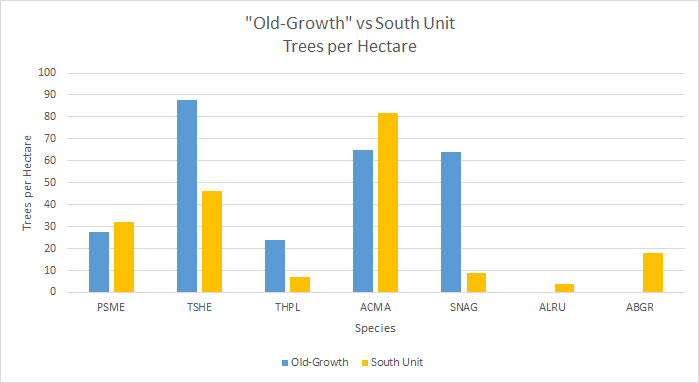This third and final blog post will be comparing data collected on 5/8 from three plots in Forest Park’s “old-growth” section with plot data from Forest Park’s South Unit. This data will eventually be used for a broader study in the park for my thesis project.
Forest Park is composed of a mosaic of different dominant vegetation alliances, or community types based on the tree species dominating the canopy. These current vegetation patterns have been driven in large part by human disturbances (logging, fragmentation, and urbanization) but also by climate and management.

My past posts have characterized a section of Forest Park that has been preserved from past logging and contains features consistent with old-growth forest types. In this final post I will compare forest structural and compositional information from this “old-growth” stand with stand conditions in the South unit of Forest Park. The forest type in the South unit is a 2nd growth mixed-conifer-deciduous stand containing a mosaic of pure Big-leaf maple stands to Douglas-fir – Western hemlock stands creating a heterogeneous mix of conifer and deciduous trees. This section is around 80-100 years old and is closest to the urban interface.

To compare forest structure and composition at both site I have summarized average DBH for all species present as well as average trees per hectare. The overall sample size is very small for each section (old growth: n = 3 and south unit: n =19), so these initial summaries should be taken with a grain of salt. It would be unwise to make broad conclusions from these summaries but there are still observable trends in forest structure and composition in this small data set.

A higher average diameter of Douglas-fir and Western red cedar trees was observed in the old-growth section as compared to the younger south unit section. The standing dead trees (snags) also had a higher average DBH in the the old-growth section. The Western hemlock diameters were similar in both sections with the south unit having a slightly higher average DBH. Most of these results were expected as the old-growth stand has been able to develop free from disturbances for a longer amount of time, allowing for greater biomass accumulation and growth. I expected the Western hemlock average DBH to be higher than the south unit, which I think will be the case with a larger sample size.

Both sections contained a similar density of Douglas-fir trees around 30 trees per hectare. There was a higher density of Western hemlock (88 trees ha-1) and Western red cedar (24 trees ha-1) in the old-growth section. There was also a drastic difference in the density of snags between each section with around 64 snags per hectare in the old-growth and 8 snags per hectare in the south unit. There was a higher density of Big-leaf maple in the south unit (82 trees ha-1) than in the old-growth section (65 trees ha-1).
These initial results were generally consistent with expectations. The South management unit consists of a 2nd growth mixed-conifer-deciduous stand that has developed after clear cut logging, wildfires and continues to be impacted by urbanization and invasive species. This legacy of land use and degradation has shifted parts of the south unit towards a more deciduous forest type composed of Big-leaf maple. The abundance of Big-leaf maple trees is one big observable difference between the two sections, which makes sense as this species often colonizes quickly after disturbances. Another big difference between the two sections is the amount of snags present. The old-growth section had a considerable larger amount of snags present than the south unit. The formation of standing dead trees is a critical component to the development towards old-growth conditions. The old-growth section has been free from disturbance for a much larger time allowing for trees to grow, die and become snags and add to the coarse woody debris load on the forest floor. There were also a higher density of Western hemlock and Western red cedar in the old growth section. This was also expected, as these species are shade-tolerant and typically develop later in Western-hemlock – Douglas fir forest types. The development of these species are described by Franklin et. al (2002) in the maturation and vertical diversification stages of old-growth forest development.
The goals of these series of posts were to give a quick glimpse into old-growth forest conditions, using a preserved section of Forest Park as a case study. Old-growth forests are characterized by the high proportion of tall, large diameter trees, standing dead trees (snags), coarse woody debris, canopy gaps and a multi-layered canopy (shade-tolerant species co-dominate). Finding undisturbed primary forests in the Coast Range of Oregon is rare and gaining a better understanding of old-growth conditions can help aid in forest management.